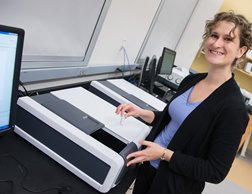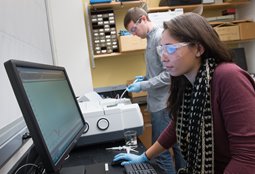Tools of the Trade
Syracuse’s new Science Equipment Excellence Fund enhances liberal arts learning

Students and faculty in Syracuse University’s College of Arts and Sciences are benefitting from a new $1 million Science Equipment Excellence Fund (SEEF).
The result of a $500,000 challenge grant made last summer by an anonymous donor, the gift has been matched by various members of the University's Board of Trustees and Chancellor Kent Syverud. SEEF is being used to modernize the College’s science-teaching instrumentation, while enhancing the overall learning experience of students.
Karin Ruhlandt, the College's dean and Distinguished Professor of Chemistry, says SEEF promotes scientific literacy, which is central to a liberal arts education, regardless of one’s major or career path.
“Students of all academic backgrounds will be able to work with the same equipment found in industry. The opportunity for collaboration between various disciplines and between students and professors is virtually unprecedented,” she adds.
Along with Syverud, Ruhlandt has been securing additional gifts for SEEF, which is expected to benefit the departments of Biology, Chemistry, Earth Sciences, and Physics, as well as the Forensics Institute of National Security Sciences.
Chemistry is the first academic unit to take advantage of SEEF, having purchased and installed more than $200,000 of instrumentation. Under the supervision of professors Tara Kahan and Mathew Maye, the department has integrated the equipment into existing and newly prepared lab experiments, with positive results.
“Already, undergraduates have gotten lots of hands-on time with the equipment,” says Kahan, an assistant professor specializing in physical chemistry, spectroscopy, and environmental and atmospheric chemistry. “Using research-grade instruments makes it easier for students to see how their studies may pay off in the future, in academia or industry or both.”
Kahan says the fund has “completely transformed” Syracuse’s physical and analytical chemistry courses, which are taken by undergraduates in both Arts and Sciences and the College of Engineering and Computer Science, as part of their core curriculum requirements.
 Professor Mathew Maye supervises a student in a "GenChem" lab class.
Professor Mathew Maye supervises a student in a "GenChem" lab class.Some of the new equipment—which includes ultraviolet-visible absorption spectrometers, fluorescence spectrometers, and infrared spectrometers—is setting the stage for novel experiments that relate chemical structures to optical properties.
“One of our new experiments enables us to see how molecules act as ‘pH probes’ to determine the acidity or basicity of a solution,” says Kahan, during a recent meeting in the Life Sciences Complex. “Another experiment measures sulfate-uptake isotherms on titanium dioxide. With our new infrared spectrometers, students get hands-on training in fundamental and vibrational spectroscopy and in modern instrument design.”
Meanwhile, new calorimeters enable students to measure heat-change during chemical reactions, as well as the heat capacities of different solutions at precisions not heretofore possible. “It’s redefining what we can accomplish in the lab,” she adds.
Paul Dent, a graduate teaching assistant and Ph.D. student in chemistry, says the new equipment provides salient learning opportunities for all students.
“The new spectrometers help students better understand the properties of proteins, which are vital to proper cell functioning,” he says.
Patrick Lutz ’11, G’13, G’15—a teaching assistant in “General Chemistry,” or “GenChem,” as it’s sometimes called—is already seeing a return-on-investment, as evidenced by students’ genuine enthusiasm for the learning material.
“Our students have seemed more focused and driven—not only to understand the lab at hand, but also to expand their knowledge of other uses of the equipment,” he says. “They’ve exhibited a greater passion for learning.”
Other faculty members agree that students of all stripes—not just STEM majors—seem to benefit from SEEF. “GenChem” lab supervisor Gary Bonomo has seen, firsthand, how the new spectrometers have elevated the study of proteins and biomolecules, in general. “The skills [students] gain from working with this equipment will serve them well in their future career paths,” he says.

One beneficiary is Tomas Smith ’16, a dual major in biochemistry and geography, who uses the new instruments several times a week. By the time he graduates, he hopes to have logged hundreds of hours on them.
“They’re identical to what you’d find in industry,” says Smith, regarding the equipment. “Although they’re light years from what we have been using, they’re relatively easy to operate. I’m putting them on my resume.”
“Mine, too,” interjects Kristina Arauz ’16, a bioengineering major. “[The equipment] has increased the complexity of our labs, while giving us greater insight into the experiments, themselves.”
Maye is not surprised by the response. He says the new equipment serves a "functional and aspirational purpose" by enabling students to learn how to operate certain instruments, as well as to collect, process, and disseminate “good data”—something scientists do on a daily basis.
 Chemistry faculty and staff, including lab supervisor Gary Bonomo (far left), agree the new equipment fosters a more research-intensive environment.
Chemistry faculty and staff, including lab supervisor Gary Bonomo (far left), agree the new equipment fosters a more research-intensive environment."The SEEF initiative not only improves the laboratory experience for students, but also enables faculty to approach teaching in bold, new ways," says James Kallmerten, professor and chair of chemistry. “I applaud everyone—professors, teaching assistants, and students —for quickly integrating the new equipment into our curriculum. By doing so, we’ve created a research-intensive environment that is redefining the possibilities of scientific inquiry and outreach.”
Media Contact
Ron Enslin
